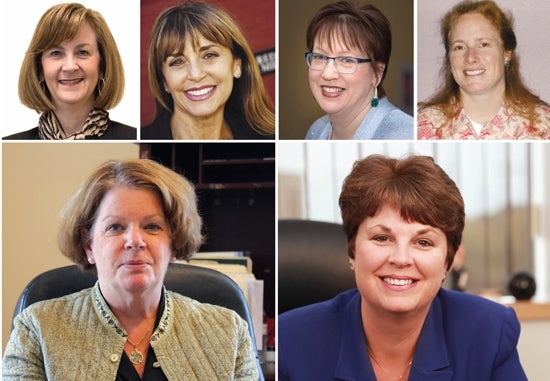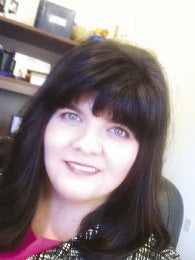Are women creating a new paradigm in chamber leadership?
Talk to the heads of local chambers of commerce, and you'll be struck by recurring themes about maintaining a vibrant organization in 2015.
In a nutshell, it's not as easy as it once was. A couple of decades ago (or even a few years ago, before the Great Recession), a local business joined its chamber of commerce as a matter of course, said Siobhan Bohnson, who was hired as president and CEO of the Milford Area Chamber of Commerce last year after an extensive search and interview process. These days, businesses think long and hard about how to spend extra money, if they have any.
“Money is tight for small businesses and people are looking at the dollars they spend … just like I am,” Bohnson said.
When it comes to persuading those businesses that membership is worth the cost, Bohnson thinks she's the right woman for the job; emphasis on the word “woman.” No, she doesn't believe women make better CEOs, but she does think that in the chamber industry, a fresh perspective is needed. And since women hold only about 15 percent of America's CEO positions, and are the chief executives for fewer than 5 percent of Fortune 500 companies, one could argue they do, in fact, offer a fresh take on business leadership.
A fresh take?
“We look at things totally differently,” Bohnson said, as she explained her decision to rebrand the Milford Area chamber with new marketing materials. “Our logo before, to me, was harsh. Now it's softer and I think it's welcoming, and as a chamber, you have to be welcoming.”
Bohnson's perspective is also unique because, before she arrived in Milford, she had never worked in the chamber industry, but spent years in business development at various banks in Central Massachusetts, plus a stint running a maternity clothing boutique in her hometown of West Boylston.
It was this, and not gender, that made Bohnson a frontrunner for the job, according to David Price, a local home health franchise owner who sits on the Milford Area chamber's board of directors. Price said the board liked the fact that Bohnson had held a number of roles in banking and frequently volunteered, most notably as a member of the West Boylston Board of Selectman.
Price said that now, more than ever, chamber executives must wear a lot of hats.
“We just wanted someone who was more nimble,” said Price, who bluntly added that Bohnson was “creative as hell.”
While Price and Bohnson were sincere in their assertions that women don't necessarily offer a more effective approach to running chambers in 2015, it's worth noting that all MetroWest-area chambers – at least those that lie within the region as MetroWest495 Biz defines it – are today led by women.
From the Corridor Nine Area chamber, which hired Karen Chapman to succeed longtime CEO Barbara Clifford last year, up to the Nashoba Valley Chamber of Commerce in Ayer, which is led by CEO Melissa Fetterhoff, who has worked there in various roles for 12 years, MetroWest-area chambers seem to welcome female chief executives.
Must have networking, problem-solving savvy
Perhaps it's the fact that women have to work a little harder to land leadership roles that makes them well-suited to chamber leadership. Kate Bett, an Upton-based consultant who helped the Milford Area chamber board with its executive search when former CEO Barry Feingold left, noted that most of the finalists for the job were women, which may have been the result of the board's wish to find an agile leader who could think outside the box when it comes to networking.
“When we look at how people get where they get, men have traditionally had more opportunities,” Bett said. “Women get ahead because they have to reach out … They have to network to build those relationships.”
Bett added that there's no understating the importance of networking when it comes to running a small nonprofit organization such as a chamber of commerce. The CEO of a large company may take a top-down approach to running the business, while a chamber CEO is “relying on the good nature of other folks” for successful operations.
Ian Scott, vice president of communications and networks for the Association of Chamber of Commerce Executives, puts it a little differently.
“I think a chamber president has to be a kick-(expletive) problem solver,” Scott said.
That's a mantra Scott isn't afraid to use, because, he said, it's simply the best way to put it. But that's nothing new. Despite the fact that membership in U.S. chambers took a dip during the recession, Scott doubts the claim that it's harder to attract members nowadays. But that doesn't mean chamber leadership doesn't take grit.
Scott, who is something of an expert on American chamber history, rattled off a number of major undertakings that were propelled by the efforts of U.S. chambers (the digging of the Erie Canal, for one). Scott said it takes a chamber of commerce acting as a middleman to provide a crucial link between the private sector and the government.
What's the ROI of chamber membership?
Scott said issues the chamber gets involved in have become more complex with time. And Scott admitted that members' expectations for return on investment are higher today than they once were, which he believes was exacerbated by the recession.
This seems to be leading chamber leaders across the region to revamp their programming, whether through scheduling networking events during business hours so working parents can attend, or by catering to young professionals, who in years past were overlooked.
Melissa Fetterhoff, the Nashoba Valley CEO, said chambers have even found it useful to partner with others on certain programs, such as speed networking and featured speaker events. “I do think it's about trying those new things. You kind of have to go with the times,” she said.
As for whether women make more effective chamber executives, Fetterhoff was skeptical.
“I'm neutral,” Fetterhoff said. “I see different personalities.”
















0 Comments